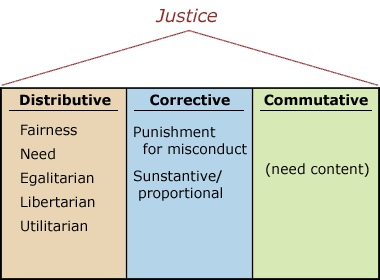Components of Justice
There are three major types of justice: Distributive, Corrective, and Commutative. Distributive justice is equity-focused, centering on the manner in which the benefits and problems of society should be allocated. Corrective justice is related to how individuals should be punished for misdeeds. Commutative justice focuses the method of achieving a fair decision between people when one believes s/he has been mistreated.Be it distributve, corrective or commutative justice, there exist shared ideas coupled with characterizations of justice. Perhaps the first idea of justice experienced and perceived by youth is fairness. Often perceptions of unequal treatment between siblings will generate friction between them and their parents. Equality pertains to uniform treatment of others people or disseminating goods and services evenhandedly. Although it may be considered part of equality, impartiality pertains to dealing with others devoid of bias or prejudice.
Distributive justice involves mounting a system whereby goods and services are dispensed fairly when scarce. Need and dessert are two criterion for determining to whom the benefits and problems of society should be conferred. Egalitarian theories hold that all persons in a society are entitled to like portions of goods and services, while Marxist theories posit that distribution of goods and services must be based on need alone. On the other hand, libertarian theories call for the distribution of goods and services to be based on individual merit and contribution with no outside intrusion from government. Finally, utilitarian theories call for goods and services to be distributed on the basis of that which is best for general good of society.
Distributive justice is primarily concerned with equal and fair allocation of such things as compensation, right of entry to education, and the ability to gain access to employment. Rawls’s theory of justice brings together rudiments of many of these theories of distributive justice. For example, all benefits present in a society should be disseminated equally with but one exception: that any system of distribution that would provide goods and services for the least advantaged should be chosen over an equal system of distribution. Rawl’s example of the veil of ignorance assists us in understanding that when we are unaware of our position in society, a system of equal distribution is the one that benefits society and us the most because it is the most fair.
Corrective justice centers on how individuals should be punished for misconduct. Substantive justice looks to circumscribe that which would be considered fair punishment. Under this rubric, the punishment meted out should be in proportion to the misconduct.
Commutative justice seeks out a middle ground whereby a person who may believe that s/he has been treated unfairly achieves a just resolution to a problem. Such occurrences usually involve situations in which certain conditions have not been met to satisfy a previous arrangement. While retributive justice searches for equilibrium between the crime and the punishment, utilitarian theories of corrective justice seek to develop punishments that will deter crime. Procedural justice attempts to delineate a fair procedure for a finding of guilt before punishment. Because rules or laws may not always be just, procedural justice helps define what would be a fair use of law. Due process is a notion in the United States legal system that mandates just and systematic treatment of persons accused of misconduct. However, it is not at all uncommon to find procedural and substantive justice in conflict.

